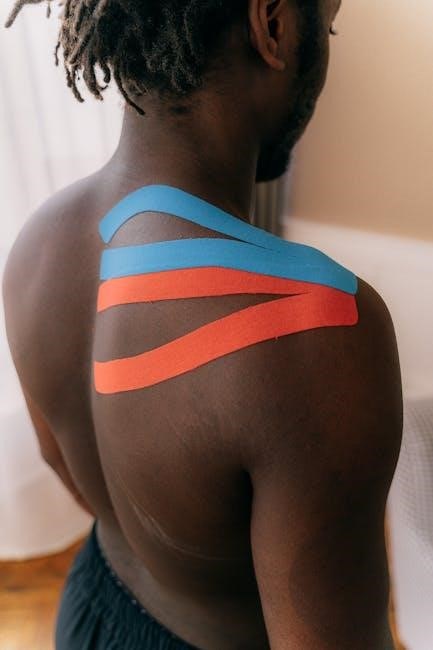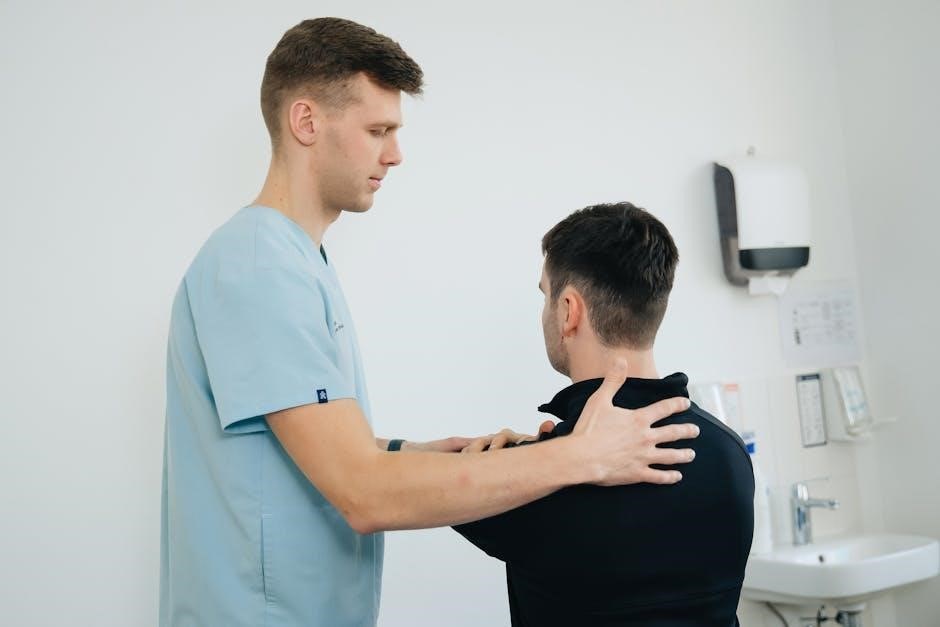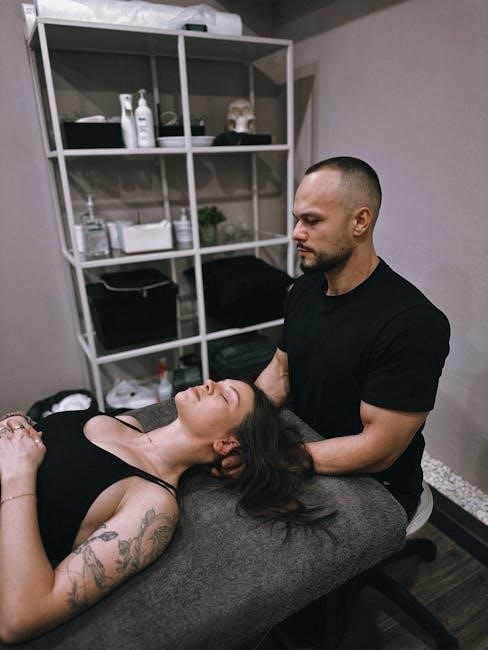Shoulder dislocation is a common injury requiring careful rehabilitation. Involving both non-surgical and surgical approaches, it aims to restore joint stability and function. This protocol outlines a structured approach to recovery.
1.1 Definition and Types of Shoulder Dislocation
A shoulder dislocation occurs when the humerus (upper arm bone) partially or fully exits the glenoid cavity (shoulder socket). It is classified into three main types: anterior (forward), posterior (backward), and inferior (downward) dislocations. Anterior dislocations are the most common, often caused by traumatic events like falls or sports injuries. Posterior dislocations are less frequent and typically result from seizures or electric shocks. Inferior dislocations are rare and involve the humerus displacing downward. Understanding these types is crucial for developing targeted rehabilitation strategies to restore shoulder stability and function. Proper diagnosis and classification guide effective treatment plans.
1.2 Importance of Proper Rehabilitation
Proper rehabilitation is essential after a shoulder dislocation to restore strength, stability, and range of motion. Without it, the shoulder may remain unstable, increasing the risk of recurrent dislocations. A structured rehabilitation program helps prevent chronic pain and ensures a safe return to daily activities or sports. It also reduces the likelihood of complications, such as arthritis or rotator cuff damage. Adhering to a well-designed protocol can significantly improve long-term outcomes, enabling patients to regain full function and confidence in their shoulder joint. Early intervention and consistent effort are key to achieving optimal recovery and minimizing future risks.

Understanding the Rehabilitation Protocol
A structured rehabilitation protocol for shoulder dislocation focuses on phased recovery, enhancing strength and stability. It ensures a safe return to normal activities and sports, promoting long-term joint health.
2.1 Overview of the Rehabilitation Process
The rehabilitation process for shoulder dislocation is divided into phases, each with specific goals. Initially, focus is on pain management and immobilization to allow healing. Gradually, mobility exercises are introduced to restore range of motion. Strengthening exercises follow to build muscle support around the shoulder joint. Finally, functional activities and sports-specific training are incorporated to ensure a full recovery. Throughout, clinical guidelines and patient adherence are crucial for optimal outcomes and preventing future dislocations.

2.2 Key Principles of the Protocol
The rehabilitation protocol is centered on gradual progression, ensuring the shoulder heals properly. It emphasizes pain-free mobilization, strengthening of surrounding muscles, and restoration of joint stability. Patient adherence to prescribed exercises is crucial, as is clinical monitoring to adjust the program as needed. The protocol also focuses on preventing recurrent dislocations by enhancing proprioception and functional strength; Each phase is tailored to the individual’s progress, ensuring a safe transition to normal activities and sports.

Treatment Options for Shoulder Dislocation
Treatment includes non-surgical and surgical approaches. Non-operative management involves immobilization, physical therapy, and exercises to restore strength and stability. Surgery may be necessary for recurrent dislocations or severe cases.
3.1 Non-Operative Management
Non-operative management focuses on immobilization, physical therapy, and exercises. Initial treatment involves immobilizing the shoulder for 4-6 weeks to allow healing. Pain management is crucial, using analgesics and ice. Gentle exercises are then introduced to improve mobility and strength. Physical therapy plays a key role in restoring joint stability and function. This approach is often recommended for first-time dislocators and those with mild instability. Progression to strength and stability exercises follows, aiming to prevent recurrence and restore full activity participation.

3.2 Operative Management
Operative management is considered for recurrent dislocations or severe instability. Surgery aims to repair or reconstruct damaged structures, such as the labrum or ligaments. Common procedures include Bankart repair or Latarjet for anterior instability. Posterior dislocations may require reverse shoulder arthroscopy. Surgery is often recommended for young, active individuals or those with significant bone defects. A structured rehabilitation program follows, emphasizing immobilization, passive exercises, and gradual strengthening. Full recovery typically takes 6-12 months, with phased physical therapy to restore mobility, strength, and stability, minimizing recurrence and optimizing functional outcomes.
3.3 Role of Physical Therapy
Physical therapy plays a pivotal role in shoulder dislocation rehabilitation, whether post-surgery or conservative management. It focuses on restoring mobility, strength, and stability. Early stages involve pain management and gentle exercises to prevent stiffness. Progression includes strengthening the rotator cuff and scapular stabilizers. Proprioceptive exercises enhance joint awareness, crucial for preventing recurrence. Tailored programs address specific deficits, ensuring a gradual return to functional activities. Collaboration between therapist and patient is key for adherence and optimal outcomes, reducing the risk of future dislocations and improving overall shoulder function.
Phases of Shoulder Dislocation Rehabilitation
Shoulder dislocation rehabilitation involves three distinct phases: immediate post-injury, intermediate, and advanced. Each phase focuses on specific goals, ensuring a progressive return to full shoulder function and stability.
4.1 Immediate Post-Injury Phase
The immediate post-injury phase focuses on pain management, swelling reduction, and shoulder immobilization. This phase typically lasts 1-2 weeks, emphasizing rest and protection to allow initial healing. Immobilization devices, such as slings, are commonly used to maintain shoulder stability. Patients are advised to avoid any movements that could exacerbate the injury. During this period, medical professionals assess the severity of the dislocation and develop a personalized recovery plan. The primary goals are to minimize discomfort and prevent further complications, ensuring the shoulder is in the best condition for subsequent rehabilitation phases.
4.2 Intermediate Phase
The intermediate phase begins once pain and inflammation have subsided, typically 2-4 weeks post-injury. This stage focuses on restoring shoulder mobility and initiating early strengthening. Gentle exercises, such as pendulum swings and passive range-of-motion activities, are introduced to improve flexibility without risking further injury; Patients are encouraged to avoid heavy lifting or repetitive movements that could strain the joint. The goal is to gradually increase functional movement while maintaining shoulder stability. This phase lays the groundwork for more advanced rehabilitation by enhancing strength and reducing stiffness.
4.3 Advanced Phase
The advanced phase focuses on restoring full shoulder strength, proprioception, and functional movement. Patients progress to dynamic stabilization exercises, plyometric drills, and sport-specific activities. This phase emphasizes improving power, endurance, and joint mechanics to prepare for return to daily activities or sports. Advanced exercises include resistance band workouts, rotational movements, and high-level balance tasks. The goal is to achieve pre-injury function, ensuring the shoulder is stable and resilient. Close monitoring by a physical therapist is crucial to prevent overloading the joint. This phase typically lasts several weeks to months, depending on the individual’s progress and goals.

Exercises in Shoulder Dislocation Rehabilitation
Exercises in shoulder dislocation rehabilitation focus on improving mobility, strength, and stability. They are tailored to restore function and prevent future dislocations, ensuring a full recovery.
5.1 Mobility Exercises
Mobility exercises are crucial in the early stages of shoulder dislocation rehabilitation. Gentle movements like pendulum swings and passive range-of-motion exercises help restore joint flexibility and ease stiffness. These exercises prevent stiffness and promote healing without putting excessive strain on the injured shoulder. Gradually increasing the range of motion ensures the shoulder regains its natural movement. It’s essential to perform these exercises consistently to avoid prolonged immobility and to prepare the shoulder for more intensive strengthening phases later in the rehabilitation process.
5.2 Strengthening Exercises
Strengthening exercises are vital for restoring shoulder stability and preventing future dislocations. These exercises target the rotator cuff muscles and scapular stabilizers, which are essential for joint integrity. Examples include shoulder blade squeezes, lateral raises, and resistance band exercises. Progressing to weight-bearing activities helps rebuild strength. These exercises typically begin once pain subsides, around 6-8 weeks post-injury. Consistency is key to rebuilding muscle endurance and ensuring proper shoulder mechanics. Supervision by a physiotherapist is recommended to ensure correct form and progression, minimizing the risk of re-injury while enhancing functional recovery.
5.3 Stability and Proprioception Exercises
Stability and proprioception exercises focus on improving joint awareness and balance, crucial for preventing recurrent dislocations. Techniques include single-arm stands, wobble board drills, and closed-chain exercises. These activities enhance neuromuscular control, helping the shoulder maintain proper positioning during movement. Proprioceptive exercises often involve controlled arm movements and resistance work. They are typically introduced in later stages of rehabilitation, once basic strength is restored. These exercises are essential for restoring functional stability, enabling patients to return to daily activities and sports safely. Regular practice ensures long-term joint stability and reduces the risk of future injuries.

Preventing Future Dislocations
Preventing future shoulder dislocations involves lifestyle adjustments, activity-specific precautions, and consistent strengthening exercises. Proper posture, avoiding risky movements, and wearing supportive gear can significantly reduce recurrence risks. Regular exercise routines targeting shoulder stability and strength are vital for long-term joint health and injury prevention. Patients should also be mindful of their physical limits during sports or heavy lifting, ensuring they maintain proper technique to safeguard their shoulders from further harm. Early detection and management of minor issues can prevent major dislocations, emphasizing the importance of ongoing care and awareness in daily activities. This proactive approach ensures sustained shoulder health and functionality.
6.1 Lifestyle Modifications
Lifestyle modifications play a crucial role in preventing future shoulder dislocations. Avoiding activities that involve repetitive overhead movements or heavy lifting can reduce strain on the shoulder joint. Improving posture through awareness and ergonomic adjustments can help distribute weight more evenly, minimizing the risk of dislocation. Maintaining a healthy weight reduces overall joint stress, while incorporating stress management techniques, such as deep breathing or yoga, can improve overall musculoskeletal health. Additionally, avoiding risky behaviors like contact sports without proper protective gear is essential. These changes, when consistently applied, contribute significantly to long-term shoulder stability and injury prevention.
6.2 Activity-Specific Tips
Activity-specific tips are crucial for preventing shoulder dislocations. For overhead sports, ensure proper technique to avoid repetitive strain. Strengthen shoulder muscles before engaging in high-risk activities. Use assistive devices like braces for added stability. Avoid heavy lifting without proper form or assistance. For contact sports, wear appropriate protective gear. Focus on controlled movements during exercises like push-ups or weightlifting. Gradually increase activity intensity to avoid sudden stress. Prioritize warm-ups and cool-downs to improve flexibility and joint stability. By tailoring activities to your shoulder’s capabilities, you can significantly reduce the risk of future dislocations and maintain long-term joint health.

When to Seek Professional Help
Seek professional help if experiencing severe pain, swelling, or limited mobility. Consult a specialist for persistent issues to prevent long-term damage and ensure proper recovery.
7.1 Signs of Complications
Recognizing complications early is crucial for effective recovery. Signs include severe pain, persistent swelling, limited mobility, or numbness. If the shoulder remains unstable or dislocates repeatedly, seek immediate medical attention. Additionally, if rehabilitation progress stalls or unusual symptoms arise, consult a specialist. Complications may indicate underlying issues requiring further evaluation or intervention. Prompt professional help ensures proper management and prevents long-term damage or chronic instability. Addressing these signs early enhances recovery outcomes and restores shoulder function effectively.
7.2 Role of Specialists in Rehabilitation
Specialists play a vital role in shoulder dislocation rehabilitation, ensuring personalized care and optimal outcomes. Orthopedic surgeons assess injury severity and recommend surgical or non-surgical approaches. Physical therapists design tailored exercise programs to restore strength and mobility. Their expertise helps address complications and prevents future dislocations. Regular follow-ups with these professionals monitor progress and adjust treatment plans. Specialists also educate patients on proper techniques and activity modifications, fostering independence and reducing recurrence risks. Their guidance accelerates recovery, enabling patients to safely return to daily activities and sports, achieving long-term shoulder stability and function.
